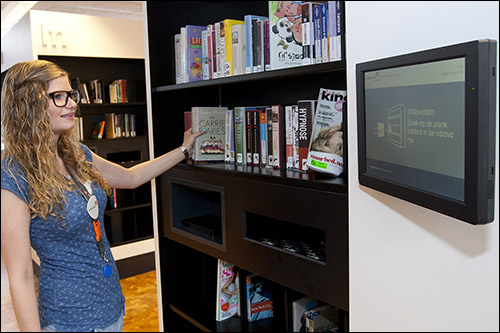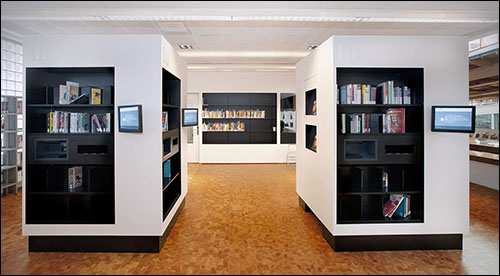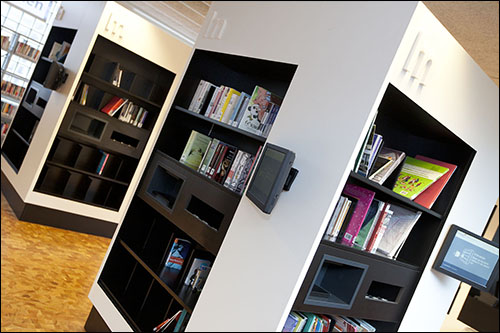Jul 26, 2017Last month, Quebec's Trois-Rivières Library District installed an RFID-based system at its three libraries, in order to automate the return of books. The technology helps to eliminate the period of time during which returned books wait to be checked in and returned to shelves. Instead, patrons return their books by placing them on the nearest shelf, at which point they immediately become available to other library card-holders.
The system is aimed at increasing the rate at which books are circulated. According to the technology provider, Nedap Library Solutions, the technology, on average, leads to the re-borrowing of 30 percent of the books on those shelves on the same day they were returned.

Nedap's system consists of high-frequency (HF) 13.56 MHz RFID readers, smart shelves with antennas, a PC and software to manage the collected data and a screen that displays information about each book's return, says Rudi Heersink, Nedap Library Solutions' marketing and communications manager. The technology was installed and integrated by Canadian solutions provider iMotion.
Many libraries are already equipped with HF RFID technology to help manage the flow of books into and out of their facilities. Typically, tagged books can be read at automated check-out desks, and again after being received when patrons place them in a returns chute or box.
However, books often may sit for hours, or even a day or more, before employees can return the books to the shelf so that other patrons can check them out. On the other hand, an RFID-based system capable of tracking the locations of all books throughout the entire library would be too expensive for most libraries. The Nedap technology offers a solution to that problem, the company reports.
The Trois-Rivières Library District receives 600,000 visitors and lends more than 1.2 million books or other media annually. It opted to install the RFID-based solution at three of its five area libraries to make the access of media more automatic. That helps it compete for attention from patrons who are more accustomed to technology-based information. "In an age [when] online retailers can get you a book instantaneously and people are glued to their mobile devices, libraries must adapt," says Shawn Korin, iMotion's director of technology projects. In addition, the technology provided the library with an opportunity to reduce the repetitive tasks of receiving, checking in and shelving books by library personnel, and enabling them to instead spend their time with patrons.
The system, compliant with the ISO 15693 standard, consists of Nedap's Intelligent Shelves units equipped with multiple antennas, each of which comes with a single Nedap EcoReader. A single, unpluggable cable connects the shelf modules to a nearby "information column," which comes with a PC, a reader and software to communicate with the library-management system (LMS).

An HF RFID tag is attached to each book at the library. When a patron returns a book, he or she enters through the front door, then proceeds to the Intelligent Shelf and places the book on the shelf. The antennas on the shelf capture the unique ID number of the book's tag, which is linked to the book's title and other details in the LMS. The system then updates that book's status in the LMS software as returned. The volume's title and its returned status are displayed on the screen so that the patron is notified that it has been received. He or she can then simply walk away.
Books can remain on the shelf at the entrance as long as the library chooses to keep them there. If the shelves become full, librarians can unplug the Intelligent Shelf (which is on wheels) and roll it away to return the books to their permanent shelves. Another Intelligent Shelf unit can be placed at the same location.

Patrons searching for a book can go directly to the Intelligent Shelves, see what has just been returned, remove a book and take it to the checkout desk.
If a patron returns a book or other item that another patron has reserved, the software can help to automate the processing of that item. The software has already received the reserved status from the library-management system, so once the book is returned, an alert is displayed for staff members that a reserved book is now available. The system automatically prints a paper "reserved" slip that they can bring to the Intelligent Shelf. They can then locate the book and set it aside so that the reserving patron can be contacted. "The software has a user-friendly interface that notifies a visitor that his or her book has been successfully returned to the library," Heersink says.

"As soon as we provided our first shelves in libraries," Korin says, "we noticed how it doesn't just help the availability of books, but also how easy and fun visitors found it to just put their five books on a shelf and be ready to browse through the library again."
The system has been popular, Korin reports—not only with adult patrons, but also with children. "We have set up a few stations and shelves geared toward the children," that come with screens positioned at a lower level, he says. "However, it was quite surprising to see the volume of both children alone, and adults guiding their children with the technology."


